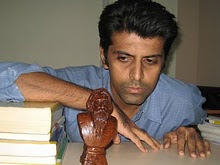Photographer/actor N L Balakrishnan has been putting together an interesting series of illustrated sketches for Matrubhumi weekly. The latest is on the late film-maker G. Aravindan. Here is a free retelling from Malayalam:
The reputation of Aravindan's 'Kanchana Sita' is based on purely artistic considerations, but I tend to remember it as a hard-hitting and uncannily prophetic political statement.
The film was shot in the jungles near Bhadrachalam, Andhra Pradesh. Members of a local tribe called 'Rama Chenchu' were chosen as the main actors. A dark-skinned and somewhat pot-bellied local chief played the role of Rama; Laxmana had a pock-marked face - plain, daring subversion. In hindsight, Aravindan appears to have done a lot more; he anticipated and condemned Ramanand Sagar's TV Ramayana and its sanitized, sanskritized and saffronized Rama, a hero ready-made for invocation by Hindu fanatics. Aravindan was fortunate he worked before the word Hindutwa became a nightmare; if he were working post 1990, zealots would have summarily buried the film.
Aravindan's Rama was no He-man but a sad, pitiable Everyman, the kind of chap one sees everyday, everywhere. And the film ends with him committing suicide - a daring interpretation of the epic's denouement.
Aravindan used to dislike Ravi Varma and his 'calender mythological paintings'. According to Aravindan, Varma's works were not only tasteless departures from our great indigenous art traditions but vulgar parodies of our epics, fit only for appropriation by cheap revivalists; he did not even deserve to be called an artist. The Rama of 'Kanchana Sita' was a frontal assault on Ravi Varma's representations of our mythical heroes.
During Sanjay Gandhi's Emergency, entire villages of tribals were subjected to compulsory sterilzation, a kind of mass castration. I heard most actors in the film had been operated upon, including its hero. The dark days of the emergency, an ancient epic turned upside down and inside out, an emasculated hero who commits suicide, impoverished tribals playing upper caste heroes, they all add up to quite a lethal package, don't they?!
My comments: While setting the film among Andhra tribals was daring (having not seen the film, I have no comments on how it worked onscreen), Aravindan was not being particularly original in any which way in making his Rama commit suicide. Valmiki ends the epic with Rama's ritual suicide - Jalasamadhi. There are many, including self, who don't think much of Ravi Varma's mythologicals; but to call him a non-artist is plain nasty and stupid; it is conceivable that Aravindan, like any artist, could be very nasty, but he certainly wasn't stupid. Moreover, the assertion that the film is a visual demolition of Ravi Varma's heroes is shaky: The picture of Rama as a muscular, clean-cut warrior striding resolutely forward is a VHP creation (that probably had its origins in Amar Chitra Kathas). The hero of Ravi Varma's Ramayana paintings was invariably a sickly wimp - in comparison, Aravindan's tribal actors actually look tough and vital (I say this based on the stills taken by Balakrishnan himself)! Balakrishnan's fears of the ruthless efficacy of Hindutwa vis-a-vis its opponents are exaggerated. Anand Patwardhan's film 'Ram ke Naam' was a no-holds-barred attack on Hindutwa, made when the Ayodhya movement was at its most intense and nothing much was done to it. The much more oblique and obscure 'Kanchana Sita' would have been a very unlikely target for the Parivar's ire(*).
Another allusion to Rama's end, this time by Paul Zachariah, writing from Arabia ( ' Nabiyude nattil' ) on the pre-Islamic Arabian king Dhu Nawas (again, my free precis from Malayalam):
"As part of his campaign against the Christian empire of Byzantium, the Jewish Dhu Nawas sacked and flattened the city of Najran. He burned and buried around 5000 of its Christian inhabitants; around 1500 of their children were sold into slavery. Sure enough, retaliation came from Byzantium's Ethiopean allies. A massive army swept across the Red Sea and wiped out Dhu Nawas's forces. Seeing no hope, Dhu Nawas mounted his steed and like Lord Rama plunging into Sarayu river, rode headlong into the sea, never to return again!".
Aside: Chariots abound in our ancient epics but there only scattered references to horse-riding. I doubt if Rama ever makes an appearance as a dashing horseman.
-------------------
(*) 'Ram ke naam'and its maker came to no known harm but the priest Lal Das, who had made some of the most daring anti-VHP statements in the documentary was murdered in 1994. The local police concluded that the murder was the result of a land dispute and had nothing to do with Ayodhya but many, if not most, observers were less than convinced.

